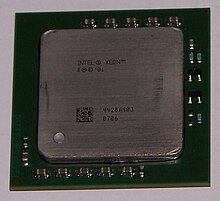Xeon E7 v3
Intel Xeon
 |
| Produced |
From 1998 to present |
| Common manufacturer(s) |
|
| Max. CPU clock rate
|
1.20 GHz to 4.40 GHz |
|
FSB speeds |
600 MHz to 8.0 GT/s |
| Instruction set |
x86-64 |
| Microarchitecture |
Skylake, Broadwell, Haswell, Ivy Bridge, Sandy Bridge, Kaby Lake, Coffee Lake, Nehalem, Core, NetBurst, P6 |
| Cores |
Up to 56, over 200
when used with dual Xeon Phi co-processors |
| Socket(s) |
|
Gallatin
 |
| Produced |
From March 2003 to 2004 |
| Max. CPU clock rate
|
1.50 GHz to 3.20 GHz |
|
FSB speeds |
400 MT/s to 533 MT/s |
| Min. feature size |
130 nm |
| Instruction set |
x86 |
| Microarchitecture |
NetBurst |
| CPUID code |
0F7x |
| Product code |
80537 |
| Cores |
1 |
| L1 cache
|
8 kB + 12 kuOps trace cache |
| L2 cache |
512 kB |
| L3 cache |
1 MB, 2 MB, 4 MB |
| Application |
DP and MP Server |
| Package(s) |
|
| Brand name(s) |
|
Paxville
| Produced |
From October 2005 to August 2008 |
| Max. CPU clock rate
|
2.667 GHz to 3.0 GHz |
|
FSB speeds |
667 MT/s to 800 MT/s |
| Min. feature size |
90 nm |
| Instruction set |
x86 |
| Microarchitecture |
NetBurst |
| CPUID code |
0F48 |
| Product code |
80551, 80560 |
| Cores |
2 |
| L2 cache |
2×2 MB |
| Application |
DP Server, MP Server |
| Package(s) |
|
| Brand name(s) |
|
Tulsa
| Produced |
From August 2006 to August 2008 |
| Max. CPU clock rate
|
2.50 GHz to 3.50 GHz |
|
FSB speeds |
667 MT/s to 800 MT/s |
| Min. feature size |
65 nm |
| Instruction set |
x86 |
| Microarchitecture |
NetBurst |
| CPUID code |
0F68 |
| Product code |
80550 |
| Cores |
2 |
| L2 cache |
2×1 MB |
| L3 cache |
16 MB |
| Application |
MP Server |
| Package(s) |
|
| Brand name(s) |
|
The Xeon is a brand of x86 microprocessors designed, manufactured, and marketed by Intel, targeted at the non-consumer workstation, server, and embedded system markets. It was introduced in June 1998. Xeon processors are based on normal desktop-grade CPUs, but have some advanced features such as support for ECC memory, higher core counts, support for larger amounts of RAM, and larger cache memory. Some also support multi-socket systems with 2, 4, or 8 sockets.
Disadvantages that make Xeon processors unsuitable for most consumer-grade desktop PCs include lower clock rates at the same price point (since servers run more tasks in parallel than desktops, so core counts become more important than clock rates), usually an absence of an integrated GPU, and lack of support for overclocking. Despite such disadvantages, Xeon processors have always had popularity among desktop users (primarily gamers, and extreme users), mainly due to higher core count potential, and lower price to performance ratio vs. the Core i7 in term of total computing power of all cores. Because most Intel Xeon CPUs lack an integrated GPU, systems built with such integrated GPU lacking processors require a discrete graphics card if a VDU output is desired.
Intel Xeon is a distinct product line from the similarly-named Intel Xeon Phi. The first-generation Xeon Phi is a completely different type of device more comparable to a graphics card; it is designed for a PCI Express slot and is meant to be used as a multi-core coprocessor, like the Nvidia Tesla. In the second generation, Xeon Phi evolved into a main processor more similar to the Xeon. It conforms to the same socket as a Xeon processor and is x86-compatible; however, as compared to Xeon, the design point of the Xeon Phi emphasizes more cores with higher memory bandwidth.
...
Wikipedia





